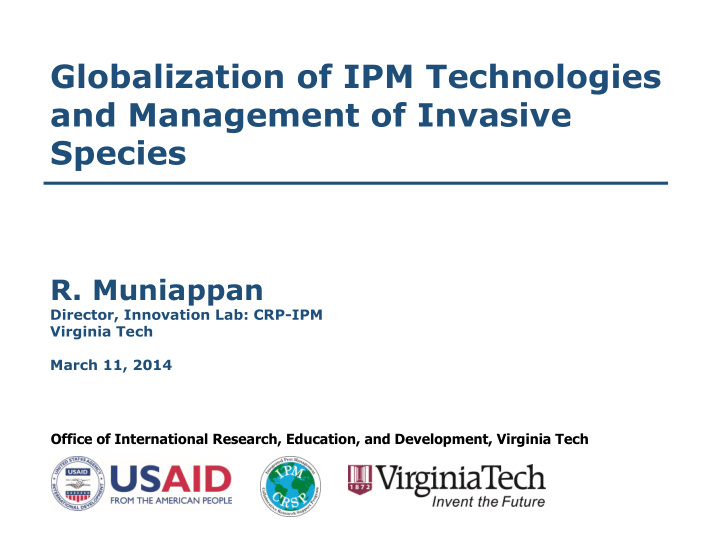



Globalization of IPM Technologies and Management of Invasive Species R. Muniappan Director, Innovation Lab: CRP-IPM Virginia Tech March 11, 2014 Office of International Research, Education, and Development, Virginia Tech
IP IPM CRS RSP P Host t Countr untry Regions ions in 2009 009 – 20 2014 6 Regions ions | 17 Countries untries Central Asia Southeast Asia Latin America South and Caribbean Asia West East Africa Africa
India Bangladesh Nepal Indonesia Kenya Tanzania Uganda Philippines Cambodia Senegal Tajikistan Honduras Mali Ghana Ecuador Guatemala
IPM package for tomato • Seed or seedling treatment with Trichoderma , Pseudomonas fluorescens, and Bacillus subtilis • Use of neem cake and other organics • Selecting resistant varieties and disease-free seeds • Grafting on resistant rootstock for bacterial wilt, Fusarium, nematodes and others • Staking and mulching • Yellow sticky traps for thrips, leafminers, whiteflies, etc. • Pheromone traps for Helicoverpa, Spodoptera and fruit flies • Rogueing and host-free period adoption for control of virus diseases • Use of biopesticides such as neem • Multiplication of parasitoids and predators for inundative releases • Production and use of microbial pesticides such as NPV, Metarhizium , and Beauveria
IPM tec techno nologies logies pri rivatized ized and sca cale led d up • Eggpla lant nt and tomato o grafting ng in Nepal, Bangladesh, India, Uganda, Mali, Senegal and others • Tricho choder derma ma in Nepal, India, Kenya, Bangladesh, Cambodia and others • Bio and microb obial al pesticide des in Nepal, India, Indonesia,, Bangladesh, and others • Pheromon omones s traps in Nepal, India, Bangladesh, Kenya and others • Parasitoi Pa oids s and Predator ors s in India, Bangladesh, Tanzania, Honduras and others
Trichoderma and Pseudomonas Trichoderma and Pseudomonas production in India Trichoderma production in Nepal Trichoderma production in Indonesia Trichoderma production in Bangladesh
Private sector in India producing Trichoderma with the strain received from TNAU State Place of Production Kerala Kottayam, Manarcadu, Moonar, Trivandrum, Palghat Karnataka Mysore, Hyderabad, Secunderabad, Guntur Maharashtra Yavatmal, Pune, Mumbai, Nashik, AP Vijayawada, Vishakhapatnam, Nellore, Rajasthan Nohar, Jaipur MP Mandasur, Indore West Bengal Medinipur, Bollygunje, Calcutta Gujarat Gujarat Tamil Nadu Coimbatore, Chennai, Theni, Others Varanasi, Ghaziabad, Allahabad Total Firms 86 – Production capacity: 17200 tonnes/annum
Production and distribution of quality seeds • Virus-free and virus- tolerant varieties • Bacterial wilt-resistant varieties • Heat-tolerant varieties • Good quality seeds • Suitable to local conditions Seed-borne Virus Diseases Workshop – Kathmandu, Nepal, April 7-11, 2014 International Seed-borne Diseases Workshop – Hyderabad, India, June 2-5, 2014
Use of trays and coconut dust for production of healthy seedlings
Eggplant and tomato grafting to overcome Bacterial wilt Eggplant grafting in Bangladesh: Eggplant yield ↑ 249% in Bangladesh • Income ↑ 305% in Bangladesh • Technology transferred from • Uganda to Ohio Technology transferred to India, Nepal, • Philippines, Uganda, Honduras, Ecuador, and Kenya Bacterial wilt and papaya mealybug workshop Dakar, Senegal, May 12-16, 2014
Production and use of pheromones Pheromone use in India Pheromone use in Bangladesh Pheromone production in India
Production of biological control agents Parasitoid production Mass culture of insects for NPV production in in Bangladesh insect pathogen production India Predaceous An egg mites production parasitoid in Honduras
Production of biopesticides Neem trees Bollcure – prepared from eucalyptus leaves by TERI, India Biopesticides Workshop, Kathmandu/Chitwan, Nepal, last week of May or Early June, 2014 Neem seed extract in Indonesia
Peanut bud necrosis virus of tomato • Transmitted by thrips • Common in India • Rogueing is effective in controlling this virus Peanut bud necrosis virus-infected tomato Unrogued field Rogued field
Papaya mealybug: Paracoccus marginatus • Native to Mexico • First described in 1992 • Caribbean: 1995-2000 • Pacific: 2000-2005 • Asia: 2008 • West Africa: 2009 IPM Innovation Lab prevented its introduction to Nepal by controlling it in southern India. Benefit to India: $500 million to $1.37 billion.
Invasive species Cassava mealybug in Indonesia Tuta absoluta in Banana leaf-roller in Nepal Senegal and Ethiopia and India Groundnut leafminer damage in Uganda
Current Invasive areas of Tuta absoluta
Invasive weed: Parthenium hysterophorus Spreading in Eastern and Southern Africa • For the biological control of Parthenium , built a quarantine facility in Ethiopia • Imported Zygogramma bicolorata • Host specificity tests completed • EA completed • Started field release in October 2013 Parthenium-infested field Zygogramma bicolorata
Sele lected Im Impacts of of th the IPM IPM IL IL Country and Crop IPM Practice(s) Net Benefits Authors (millions) Uganda, Moyo et al, Peanuts Virus resistant variety $33-36 2007 Mali, Nouhoheflin, et Tomato Cultural $21-24 al, 2011 Uganda, Debass, 2000 Beans and maize Cultural $36-202 Bangladesh, Debass, Eggplant, cabbage Cultural practices $26-29 2000 Bangladesh, Rakshit et Cucurbits Pheromone traps $3-6 al, 2011 Ecuador, Baez, 2004 Plantain Cultural $59-63 Ecuador, Quishpe, Potatoes Resistant variety $50 2001 Albania, Daku, 2002 Olives Cultural $39-52 Honduras, Sparger, et Eggplant, onion, Cultural practices $17 al, 2011 tomato, and pepper India, Myrick, et al, Mulberry, papaya, Papaya mealybug $500 - 1,370 2014 cassava parasitoid release
IPM PM CRS RSP P Cost: st: Benef enefit it Ra Ratio tio • IPM CRSP Budget for 20 Years $50 Million • Benefits from IPM CRSP $784 to 1,849 Millions • Cost:Benefit 1:15 to 37 (This ratio is based on impact assessment of 10 IPM technologies implemented in 10 countries. Over 100 more technologies implemented are yet to be assessed. Assessing these may lead to a ratio of 1:150 to 300 )
Women coffee growers in Nepal Members of a women coffee- grower’s association meet to discuss the group’s latest activities.
Thank You!
Recommend
More recommend